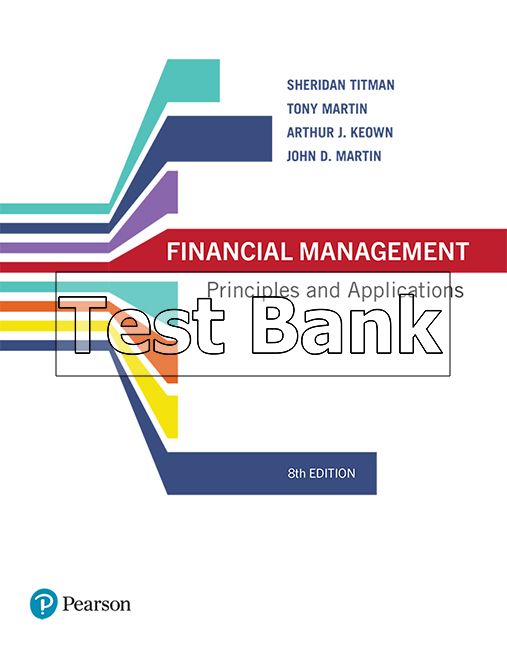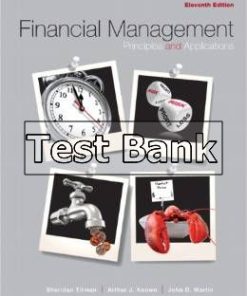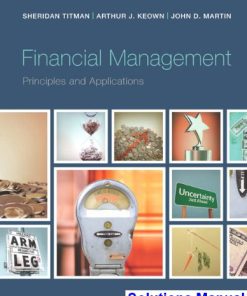Financial Management Principles and Applications Australia 8th Edition Titman Test Bank
$26.50$50.00 (-47%)
Financial Management Principles and Applications Australia 8th Edition Titman Test Bank.
You may also like
Financial Management Principles and Applications Australia 8th Edition Titman Test Bank

Product details:
- ISBN-10 : 148861721X
- ISBN-13 : 978-1488617218
- Author: Sheridan Titman
Financial Management is a total learning package that reflects the vitality of an ever-expanding discipline, building on the foundations of economics and accounting.
Adapted for the Australian market, students are presented with a cohesive, inter-related subject that they can use when approaching problems. Building on the strengths of the previous edition, this edition refines content, creating a modern teaching approach.
Five key principles are woven throughout the text using multiple teaching methods, forming a rationalised, coherent, integrated and intuitive problem-solving approach.
Table contents:
- Part 1 Introduction to financial management
- Chapter 1 Getting started—Principles of finance
- Finance Spotlight Welcome to the world of finance
- 1.1 Finance: an overview
- What is finance?
- Why study finance?
- 1.2 Three types of business organisation
- Sole proprietorship
- Partnership
- Corporation
- How does finance fit into a firm’s organisational structure?
- 1.3 The goal of the financial manager
- Maximising shareholder wealth
- Ethical considerations in corporate finance
- Finance Spotlight Ethical considerations arising from Bond issues
- 1.4 The five basic principles of finance
- Principle 1: Money has a time value
- Principle 2: There is a risk-return trade-off
- Principle 3: Cash flows are the source of value
- Principle 4: Market prices reflect information
- Principle 5: Individuals respond to incentives
- Chapter summary
- Study questions
- Endnotes
- Chapter 2 Firms and the financial market
- Finance Spotlight Superannuation—defined benefit versus defined contribution
- 2.1 The basic structure of the Australian financial markets
- 2.2 The financial marketplace: financial institutions
- Commercial banks: everyone’s financial marketplace
- Non-bank financial intermediaries
- Investment companies
- Finance Spotlight Controlling costs in managed funds
- 2.3 The financial marketplace: securities markets
- How securities markets bring corporations and investors together
- Types of security
- Stock markets
- Finance Spotlight Where’s the money around the world?
- Financial markets and the Global Financial Crisis (GFC)
- Chapter summary
- Study questions
- Endnotes
- Chapter 3 Understanding financial statements, taxes and cash flows
- 3.1 An overview of the firm’s financial statements
- Finance Spotlight Accounting is the language of business
- Basic financial statements
- Why study financial statements?
- What are the accounting principles used to prepare financial statements?
- 3.2 The income statement
- Income statement of H. J. Boswell Ltd
- Connecting the income statement and the balance sheet
- Interpreting firm profitability using the income statement
- IFRS and earnings management
- Checkpoint 3.1 Constructing an income statement
- 3.3 Corporate tax, personal tax and dividend imputation
- Calculating taxable income and company tax payable
- Personal income tax and capital gains tax
- Checkpoint 3.2 Calculation of personal income tax and capital gains tax
- Dividend imputation
- Checkpoint 3.3 Comparison between a classical tax system and a dividend imputation tax system
- 3.4 The balance sheet
- The balance sheet of H. J. Boswell Ltd
- Firm liquidity and net working capital
- Debt and equity financing
- Checkpoint 3.4 Constructing a balance sheet
- Book values, historical costs and market values
- Finance Spotlight Your personal balance sheet and income statement
- 3.5 The cash flow statement
- Sources and uses of cash
- H. J. Boswell’s cash flow statement
- Finance Spotlight IFRS versus GAAP
- Checkpoint 3.5 Interpreting the statement of cash flows
- Chapter summary
- Study questions
- Study problems
- Mini-case
- Endnotes
- Chapter 4 Financial analysis: sizing up firm performance
- Finance Spotlight Financial ratios and business
- 4.1 Why do we analyse financial statements?
- 4.2 Common-size statements: standardising financial information
- The common-size income statement: H. J. Boswell Ltd
- The common-size balance sheet: H. J. Boswell Ltd
- 4.3 Using financial ratios
- Liquidity ratios
- Checkpoint 4.1 Evaluating James Hardie Industries PLC’s liquidity
- Capital structure ratios
- Asset management efficiency ratios
- Checkpoint 4.2 Comparing the financing decisions of Wesfarmers Ltd and Woolworths Ltd
- Profitability ratios
- Checkpoint 4.3 Evaluating the return on assets for Wesfarmers Ltd and Woolworths Ltd
- Market value ratios
- Finance Spotlight Your cash budget and personal savings ratio
- Checkpoint 4.4 Comparing Treasury Wine Estates with Australian Vintage using market value ratios
- Summing up the financial analysis of H. J. Boswell Ltd
- Finance Spotlight Ratios and international accounting standards
- 4.4 Selecting a performance benchmark
- Trend analysis
- Peer-firm comparisons
- 4.5 Limitations of ratio analysis
- Chapter summary
- Study questions
- Study problems
- Mini-case
- Endnotes
- Part 2 Valuation of financial assets
- Chapter 5 The time value of money—The basics
- Finance Spotlight A dollar saved is two dollars earned
- 5.1 Using timelines to visualise cash flows
- Checkpoint 5.1 Creating a timeline
- 5.2 Compounding and future value
- Compound interest and time
- Compound interest and the interest rate
- Techniques for valuing cash flows at different points in time
- Applying compounding to things other than money
- Checkpoint 5.2 Calculating the future value of a cash flow
- Compound interest with shorter compounding periods
- Checkpoint 5.3 Calculating future values using non-annual compounding periods
- Finance Spotlight Saving for your first house
- 5.3 Discounting and present value
- The mechanics of discounting future cash flows
- Checkpoint 5.4 Solving for the present value of a future cash flow
- Discounting with shorter discounting periods
- Two additional types of discounting problem
- The Rule of 72
- Checkpoint 5.5 Solving for the number of periods, n
- Checkpoint 5.6 Solving for the interest rate, i
- 5.4 Making interest rates comparable
- Calculating the interest rate and converting it to an EAR
- Checkpoint 5.7 Calculating an effective annual rate (EAR)
- To the extreme: continuous compounding
- Chapter summary
- Study questions
- Study problems
- Mini-case
- Chapter 6 The time value of money—Annuities and other topics
- Finance Spotlight Annuities we all know
- 6.1 Annuities
- Ordinary annuities
- Checkpoint 6.1 Solving for an ordinary annuity payment
- Checkpoint 6.2 The present value of an ordinary annuity
- Amortised loans
- Checkpoint 6.3 Determining the outstanding balance of a loan
- Annuities due
- Finance spotlight Saving for retirement
- 6.2 Perpetuities
- Calculating the present value of a level perpetuity
- Checkpoint 6.4 The present value of a level perpetuity
- Calculating the present value of a growing perpetuity
- Checkpoint 6.5 The present value of a growing perpetuity
- 6.3 Complex cash-flow streams
- Checkpoint 6.6 The present value of a complex cash-flow stream
- Chapter summary
- Study questions
- Study problems
- Mini-case
- Chapter 7 Risk and return—An introduction: history of financial market returns
- Finance Spotlight Using statistics
- 7.1 Realised and expected rates of return and risk
- Calculating the realised return from an investment
- Calculating the expected return from an investment
- Measuring risk
- Checkpoint 7.1 Evaluating an investment’s return and risk
- 7.2 A brief history of financial market returns
- Australian financial markets: domestic investment returns
- Lessons learned
- Australian shares versus other categories of investment
- Global financial markets: international investing
- Finance Spotlight Determining your tolerance for risk
- 7.3 Geometric versus arithmetic average rates of return
- Calculating the geometric or compound average rate of return
- Choosing the right ‘average’
- Checkpoint 7.2 Calculating the arithmetic and geometric average rates of return
- 7.4 What determines share prices?
- The efficient markets hypothesis
- Do we expect financial markets to be perfectly efficient?
- Market efficiency: what does the evidence show?
- Chapter summary
- Study questions
- Study problems
- Mini-case
- Endnotes
People also search:
financial management principles and applications australia 8th
financial management principles and applications australia 8th pdf
financial management principles and applications australia 8th quizlet
financial management principles and applications australia 8th pdf free
financial management principles and applications australia












